Carolina, Puerto Rico
Carolina (Spanish pronunciation: [kaɾoˈlina]) is a municipality located on the northeast coast of Puerto Rico. It lies immediately east of the capital San Juan and Trujillo Alto; north of Gurabo and Juncos; and west of Canóvanas and Loíza. Carolina is spread over 12 wards plus Carolina Pueblo (the downtown area and administrative center). It is part of the San Juan-Caguas-Guaynabo Metropolitan Statistical Area, and home to Puerto Rico's main airport, the Luis Muñoz Marín International Airport.
Carolina Municipio Autónomo de Carolina | |
|---|---|
Municipality | |
 Buildings along Isla Verde Ave. in Carolina | |
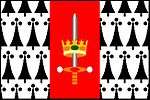 Flag | |
| Nicknames: "Tierra de Gigantes" Spanish for "Land of Giants" "El Pueblo de los Tumba Brazos" Spanish for "Arm Hackers Town" | |
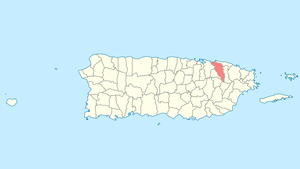 Map of Puerto Rico highlighting Carolina Municipality | |
| Coordinates: 18°24′22″N 65°58′2″W | |
| Commonwealth | |
| Founded | 1857 |
| Wards | |
| Government | |
| • Mayor | Jose C. Aponte Dalmau (PPD) |
| • Senatorial dist. | 8 - Carolina |
| • Representative dist. | 38, 39, 40 |
| Area | |
| • Total | 60.34 sq mi (156.29 km2) |
| • Land | 45.3 sq mi (117.4 km2) |
| • Water | 15.02 sq mi (38.89 km2) |
| Elevation | 52 ft (16 m) |
| Population (2010) | |
| • Total | 176,762 |
| • Density | 2,900/sq mi (1,100/km2) |
| Demonym(s) | Carolinenses |
| Time zone | UTC−4 (AST) |
| ZIP Codes | 00979, 00982, 00983, 00985, 00987, 00981, 00984, 00986, 00988 |
| Area code(s) | 787/939 |
| Major routes | |
| Website | www |
History
The town was founded by Spanish colonists in 1816 as Trujillo Bajo ("lower Trujillo"), along with its counterpart Trujillo Alto after Trujillo, Spain. In 1857 it was renamed to San Fernando de la Carolina, later shortened to Carolina, after Charles II of Spain.[1]
The city is known as "Tierra de Gigantes" (Land of Giants), not only for well-known Carolina resident Don Felipe Birriel González (who was 7'11"), but also in honor of other people from Carolina, including poet Julia de Burgos and most notably the first Latin American player named to baseball's Hall of Fame, Roberto Clemente. Carolina was also home to Jesús T. Piñero, the first Puerto Rican to be appointed as governor by the United States government. The city is also known as "El Pueblo de los Tumba Brazos" (The Arm Hackers Town). During the late 1800s, the town's major export was sugar cane. Sugar cane workers solved their issues by fighting with their machetes, and therefore many lost their arms.
In 1899, Carolina had a total population of 11,965.[2]
Geography
Carolina municipality has a number of rivers such as the Río Canovanillas, Río Grande de Loíza, La Torrecilla, Piñones Lagoons.[3]
Barrios
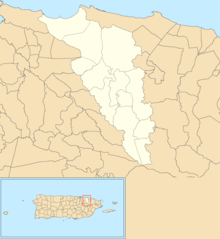
Like all municipalities of Puerto Rico, Carolina is subdivided into barrios. The municipal buildings, central square and large Catholic church are located in a small barrio referred to as "el pueblo", near the center of the municipality.[4][5][6]
Sectors
Barrios (which are like minor civil divisions)[7] in turn are further subdivided into smaller local populated place areas/units called sectores (sectors in English). The types of sectores may vary, from normally sector to urbanización to reparto to barriada to residencial, among others.[8][9][10]
Special Communities
Of the 742 places on the list of Comunidades Especiales de Puerto Rico, the following barrios, communities, sectors, or neighborhoods were in Carolina in 2014: Colo, Martín González, Buena Vista, Buenaventura, Canovanillas (Estancias del Parque), Cuesta Quiles, Eduardo J. Saldaña - La Cerámica, La Villas (Justicia y Esperanza), Sabana Abajo Norte, Sabana Abajo Sur, Saint Just, San Antón, and Villa Caridad.[11][12]
Demographics
The United States took control of Puerto Rico from Spain in the aftermath of the Spanish-American War under the terms of the Treaty of Paris of 1898 and conducted its first census of Puerto Rico, finding that the population of Carolina was 11,965.
| Historical population | |||
|---|---|---|---|
| Census | Pop. | %± | |
| 1900 | 11,965 | — | |
| 1910 | 15,327 | 28.1% | |
| 1920 | 15,563 | 1.5% | |
| 1930 | 18,751 | 20.5% | |
| 1940 | 24,046 | 28.2% | |
| 1950 | 29,224 | 21.5% | |
| 1960 | 40,923 | 40.0% | |
| 1970 | 107,643 | 163.0% | |
| 1980 | 165,954 | 54.2% | |
| 1990 | 177,806 | 7.1% | |
| 2000 | 186,076 | 4.7% | |
| 2010 | 176,762 | −5.0% | |
| U.S. Decennial Census[13] 1899 (shown as 1900)[14] 1910-1930[15] 1930-1950[16] 1960-2000[17] 2010[5] | |||
Tourism
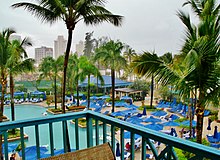
Carolina is one of Puerto Rico's most important tourist centers. Luis Muñoz Marín International Airport, the territory's main airport, is located in Isla Verde. Also located in Carolina are a large group of hotels, which sit by Carolina's large beach area.
There are several well-known hotels on the coast of Carolina (Isla Verde area), including the El San Juan Resort and Casino, InterContinental San Juan Hotel and the Ritz-Carlton San Juan Hotel, Spa, and Casino. Isla Verde has an Orthodox Jewish synagogue, Chabad of Puerto Rico,[18] the only Orthodox Jewish synagogue in Puerto Rico, which serves the island's Jewish residents and visiting tourists.
Landmarks and places of interest
There are 4 beaches in Carolina, including Balneario de Isla Verde.[19]
- Buena Vista Ruins
- Carolina Beach
- Loíza's Big River
- Isla Verde Club Gallístico
- Luis Muñoz Marín International Airport
- Jesús T. Piñero Monument
- Julia de Burgos Park
- Piñones Beach
- Roberto Clemente Ciudad Deportiva
Economy
Carolina is the home of Plaza Carolina, one of Puerto Rico's largest shopping malls.
Executive Airlines, an aircraft ground handling company and subsidiary of American Airlines, is headquartered on the grounds of Luis Muñoz Marín International Airport in Carolina.[20]
Industrial
Manufacturing (pharmaceutical, medical equipment and chemical) and commerce.
Culture
Festivals and events
Carolina celebrates its patron saint festival in late May / early June. The Fiestas Patronales de San Fernando is a religious and cultural celebration that generally features parades, games, artisans, amusement rides, regional food, and live entertainment.[3][21]
Other festivals and events celebrated in Carolina include:
- Jazz night- third Friday of the month
- Bohemia night – second Thursday of the month
- Youth night- first Friday every two months
- Artisans' Market- one Sunday a month
- Roberto Clemente’s week- August
Sports
In recent years, Carolina has seen the building of the Ciudad Deportiva Roberto Clemente or Roberto Clemente Sports City, a sports and recreation facility that aims to become a youth sports school, and the Roberto Clemente Stadium, host to many entertainment events and to the 2003 and 2007 Caribbean World Series. It has also played host to the Coliseo Guillermo Angulo, where the BSN's Gigantes de Carolina play, as well as the Gigantes of Puerto Rican women's professional basketball, the Gigantes of men's professional volleyball, and the Gigantes of women's professional volleyball.
The Gigantes de Carolina professional baseball team use the Roberto Clemente Stadium as their home field. There is also another team with the same name, the Giants de Carolina, a professional soccer team that plays in the Puerto Rico Soccer League. That team also uses the Roberto Clemente Stadium as its home field.
Professional horse jockey Emanuel Jose Sanchez was born in Carolina, Puerto Rico. Riding the mare Mark Me Special he captured the 7th race at Colonial Downs on June 19, 2005.
Demographics
| Race - Carolina, Puerto Rico - 2010 Census[22] | ||
|---|---|---|
| Race | Population | % of Total |
| White | 113,683 | 64.3% |
| Black/Afro-Puerto Rican | 40,310 | 22.8% |
| American Indian and Alaska Native | 1,514 | 0.9% |
| Asian | 625 | 0.4% |
| Native Hawaiian/Pacific Islander | 13 | 0.0% |
| Other | 14,832 | 8.4% |
| Two or more races, mixed | 5,785 | 3.3% |
Government
All municipalities in Puerto Rico are administered by a mayor, elected every four years. The current mayor of Carolina is José Aponte Dalmau, of the Popular Democratic Party (PPD). He was elected in 2007, after a special election, succeeding his late father, José Aponte de la Torre. Aponte de la Torre was elected mayor in 1984 and served for 23 years.
The city belongs to the Puerto Rico Senatorial district VIII, which is represented by two Senators. In 2012, Pedro A. Rodríguez and Luis Daniel Rivera were elected as District Senators.[23]
The Carolina Police Department, with most of its precincts in the northern half of the city due to the density of the population, handle law enforcement responsibilities. Puerto Rico Police Department also has jurisdiction in Carolina, especially for narcotics enforcement, with four precincts positioned on all four points of the city.
Carolina created the first municipal fire department in Puerto Rico. The Carolina Fire Department in collaboration with the Carolina Municipal Emergency Management use two engine trucks, one ladder track and one special hazard engine truck. Their headquarters are located in the tourist district of Isla Verde. Also, the Puerto Rico Fire Department have a fire station and regional office in town, located on the Roberto Clemente Avenue.
Transportation
There are 72 bridges in Carolina.[24]
Symbols
Flag
The flag consists of three vertical bands, the laterals white and the middle red. The laterals are seeded with black ermine tails in the heraldic way as for the coat of arms. The middle band of the flag shows a red field with the sword and crown of the coat of arms.
Coat of arms
The crown over the sword is the main attribute for royalty and for that reason it occupies a privileged position in the coat of arms. The sword is not only a symbol for military service, but also one of justice, recalling the virtues of San Fernando. The coat of arms has a wide edge of silver, a cultivated field of small tails of ermine shown in the conventional heraldic manner. The red symbolizes the first patriotic developments made for Puerto Rico's freedom under Spanish dominion.
Notable people from Carolina
Gallery
 Beach in Carolina
Beach in Carolina Isla Verde skyline in Carolina
Isla Verde skyline in Carolina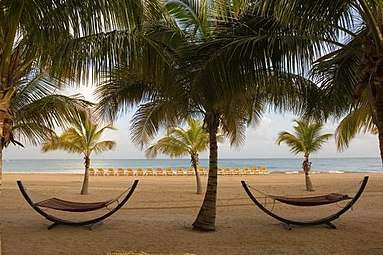 Courtyard by Marriott in Isla Verde Beach Resort
Courtyard by Marriott in Isla Verde Beach Resort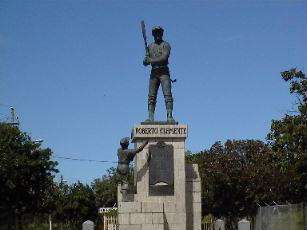 Statue of Roberto Clemente located at entrance of Ciudad Deportiva Roberto Clemente
Statue of Roberto Clemente located at entrance of Ciudad Deportiva Roberto Clemente- Aerial view of the city
References
- Adrian Room (2006). "Carolina". Placenames of the World. McFarland & Co. p. 79. ISBN 0-7864-2248-3.
- Joseph Prentiss Sanger; Henry Gannett; Walter Francis Willcox (1900). Informe sobre el censo de Puerto Rico, 1899, United States. War Dept. Porto Rico Census Office. Imprenta del gobierno. p. 159. Retrieved 2019-01-11.
- "Carolina Municipality". enciclopediapr.org. Fundación Puertorriqueña de las Humanidades (FPH). Archived from the original on 2019-05-02. Retrieved 2019-03-20.
- Gwillim Law (20 May 2015). Administrative Subdivisions of Countries: A Comprehensive World Reference, 1900 through 1998. McFarland. p. 300. ISBN 978-1-4766-0447-3. Retrieved 25 December 2018.
- Puerto Rico:2010:population and housing unit counts.pdf (PDF). U.S. Dept. of Commerce Economics and Statistics Administration U.S. Census Bureau. 2010. Archived (PDF) from the original on 2017-02-20. Retrieved 2018-12-28.
- "Map of Carolina" (PDF). Archived from the original (PDF) on 2011-06-08. Retrieved 2007-12-13.
- "US Census Barrio-Pueblo definition". factfinder.com. US Census. Archived from the original on 13 May 2017. Retrieved 5 January 2019.
- "Agencia: Oficina del Coordinador General para el Financiamiento Socioeconómico y la Autogestión (Proposed 2016 Budget)". Puerto Rico Budgets (in Spanish). Retrieved 28 June 2019.
- Rivera Quintero, Marcia (2014), El vuelo de la esperanza: Proyecto de las Comunidades Especiales Puerto Rico, 1997-2004 (first ed.), San Juan, Puerto Rico Fundación Sila M. Calderón, ISBN 978-0-9820806-1-0
- "Leyes del 2001". Lex Juris Puerto Rico (in Spanish). Retrieved 24 June 2020.
- Rivera Quintero, Marcia (2014), El vuelo de la esperanza: Proyecto de las Comunidades Especiales Puerto Rico, 1997-2004 (1st ed.), San Juan, Puerto Rico Fundación Sila M. Calderón, p. 273, ISBN 978-0-9820806-1-0
- "Comunidades Especiales de Puerto Rico" (in Spanish). 8 August 2011. Archived from the original on 24 June 2019. Retrieved 24 June 2019.
- "U.S. Decennial Census". United States Census Bureau. Archived from the original on April 26, 2015. Retrieved September 21, 2017.
- "Report of the Census of Porto Rico 1899". War Department Office Director Census of Porto Rico. Archived from the original on July 16, 2017. Retrieved September 21, 2017.
- "Table 3-Population of Municipalities: 1930 1920 and 1910" (PDF). United States Census Bureau. Archived (PDF) from the original on August 17, 2017. Retrieved September 21, 2017.
- "Table 4-Area and Population of Municipalities Urban and Rural: 1930 to 1950" (PDF). United States Census Bureau. Archived (PDF) from the original on August 30, 2015. Retrieved September 21, 2014.
- "Table 2 Population and Housing Units: 1960 to 2000" (PDF). United States Census Bureau. Archived (PDF) from the original on July 24, 2017. Retrieved September 21, 2017.
- https://www.jewishpuertorico.com/
- "Las 1,200 playas de Puerto Rico [The 1200 beaches of Puerto Rico]". Primera Hora (in Spanish). April 14, 2017. Archived from the original on December 12, 2019. Retrieved December 12, 2019.
- "Regional3.pdf ." Aviation Week. Retrieved on September 28, 2009.
- "Puerto Rico Festivales, Eventos y Actividades en Puerto Rico". Puerto Rico Hoteles y Paradores (in Spanish). Retrieved 2020-07-17.
- "Ethnicity 2010 census". Retrieved 2011-11-10.
- Elecciones Generales 2012: Escrutinio General Archived 2013-01-23 at the Wayback Machine on CEEPUR
- "Carolina Bridges". National Bridge Inventory Data. US Dept. of Transportation. Archived from the original on 21 February 2019. Retrieved 21 February 2019.
External links
| Wikimedia Commons has media related to Carolina, Puerto Rico. |
- Puerto Rico Government Directory (in Spanish)